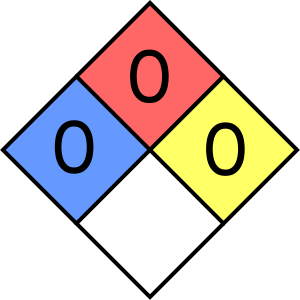SODIUM CHLORIDE
Basic information
- Chemical formula(s): \({\rm NaCl}\)
- Other names: Common salt, table salt, halite, rock salt, saline
- CAS number: 7647-14-5
- EC number: 231-598-3
- Molecular weight: 58.44 g/mol
- International Chemical Safety Card (ICSC): 1119
- Flammability: no (not combustible)
- Description: White crystalline solid. Highly soluble in water (36 g/100ml at 20°C). Essential nutrient and food preservative. Used in chemical synthesis and de-icing.
NFPA 704 (fire diamond)

- Health (blue): 0 - poses no health hazard.
- Flammability (red): 0 - will not burn under typical fire conditions.
- Instability–reactivity (yellow): 0 - normally stable, even under fire exposure conditions, and is not reactive with water.
- Special notice (white): - - no special hazards.
Hazard statements
Sodium chloride has minimal hazard classification under GHS regulations:
| Code | Phrase |
|---|---|
| H319 | causes serious eye irritation |
Precautionary statements
| Code | Phrase |
|---|---|
| P264 | wash hands thoroughly after handling |
| P280 | wear protective gloves/protective clothing/eye protection/face protection |
| P305+P351+P338 | IF IN EYES: rinse cautiously with water for several minutes, remove contact lenses if present and easy to do, continue rinsing |
| P337+P313 | if eye irritation persists: get medical advice/attention |
Protective measures
Gloves
For routine handling of sodium chloride:
- Any standard laboratory gloves: very good - sodium chloride is non-toxic and minimally irritating.
- Nitrile: very good - prevents contamination and provides good grip.
- Natural latex or rubber: very good - adequate for handling salts.
- Vinyl: very good - suitable for food-grade applications.
- PVC: good - adequate protection for non-hazardous salts.
Safety goggles
- Standard safety glasses recommended when handling powder to prevent eye irritation.
- Corrective glasses are not considered safety goggles.
- Important: Can cause serious eye irritation if powder contacts eyes.
Clothing
- Standard laboratory clothing is sufficient.
- Long sleeves recommended when handling large quantities to minimize skin contact with dust.
- Closed-toe shoes required as standard laboratory safety.
- No special protective clothing required for food-grade material.
Respiratory protection
- Generally not required under normal use conditions.
- Dust mask recommended when handling large quantities of fine powder.
- Ensure adequate ventilation to prevent dust accumulation.
- Minimize dust generation during handling.
Spill management
- Sweep up material carefully to minimize dust generation.
- Use vacuum with appropriate filtration if available.
- Avoid creating dust clouds during cleanup.
- Collect in appropriate container - can be disposed as non-hazardous waste.
- Clean area with water to remove residual salt.
- Environmental consideration: Avoid release to waterways in large quantities (can affect aquatic life).
- No special disposal requirements - non-hazardous material.
Special warnings
- Generally recognized as safe (GRAS) - essential nutrient and food ingredient.
- Eye irritant - fine powder can cause serious eye irritation.
- Hygroscopic - absorbs moisture from air at high humidity (>75%).
- Corrosive to metals - concentrated solutions can corrode some metals over time.
- De-icing agent - can damage vegetation and corrode infrastructure if overused.
- Store in cool, dry place in tightly closed containers.
- Food-grade vs. technical grade - ensure appropriate grade for intended use.
- Aquatic toxicity: LC50 fish: 5,840 mg/L (96h), Daphnia: 874 mg/L (48h).
- Medical note: Excessive intake may contribute to hypertension in sensitive individuals.
- Physical hazard: Can make surfaces slippery when wet.
- Compatible with most materials under normal conditions.